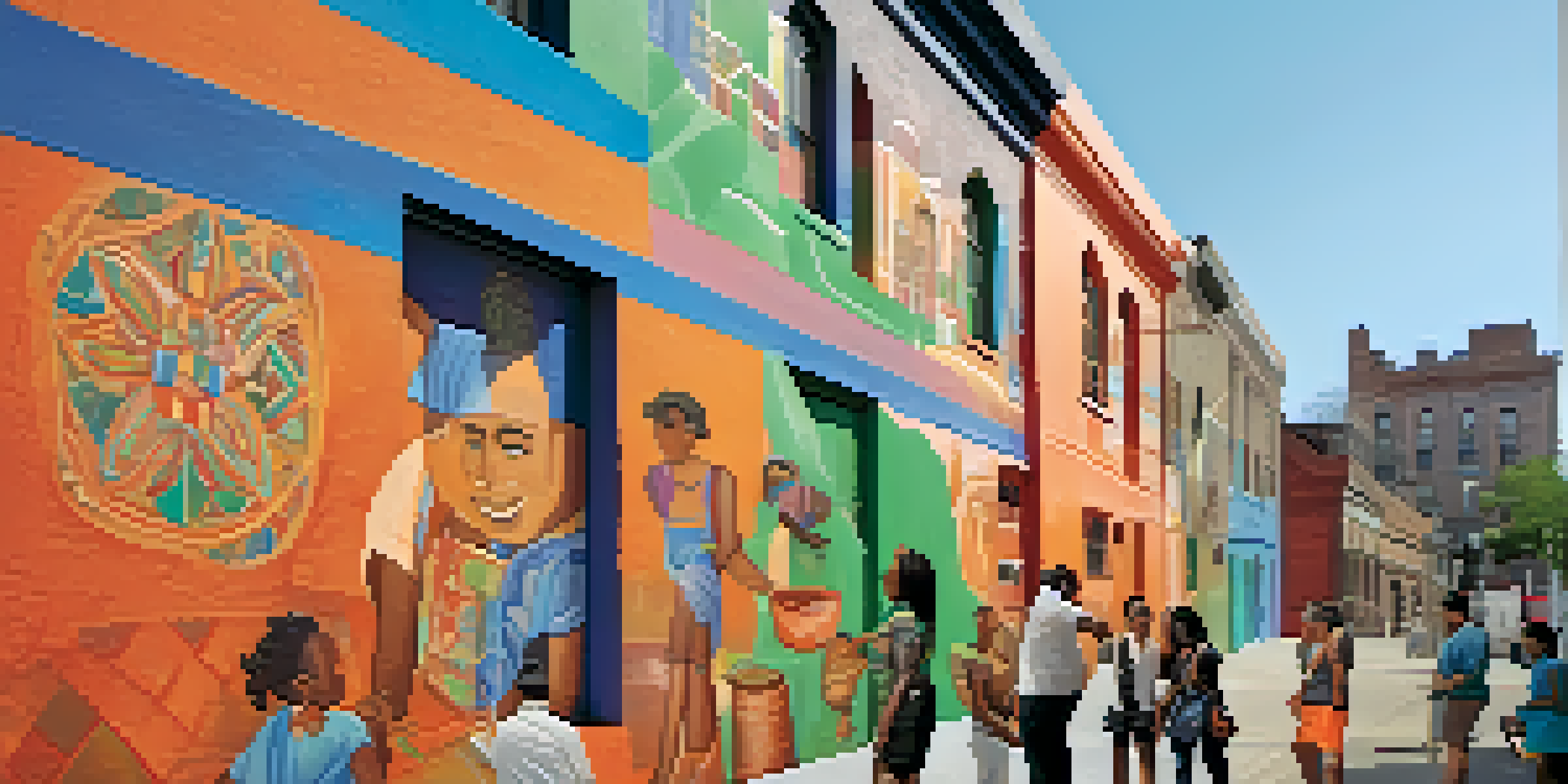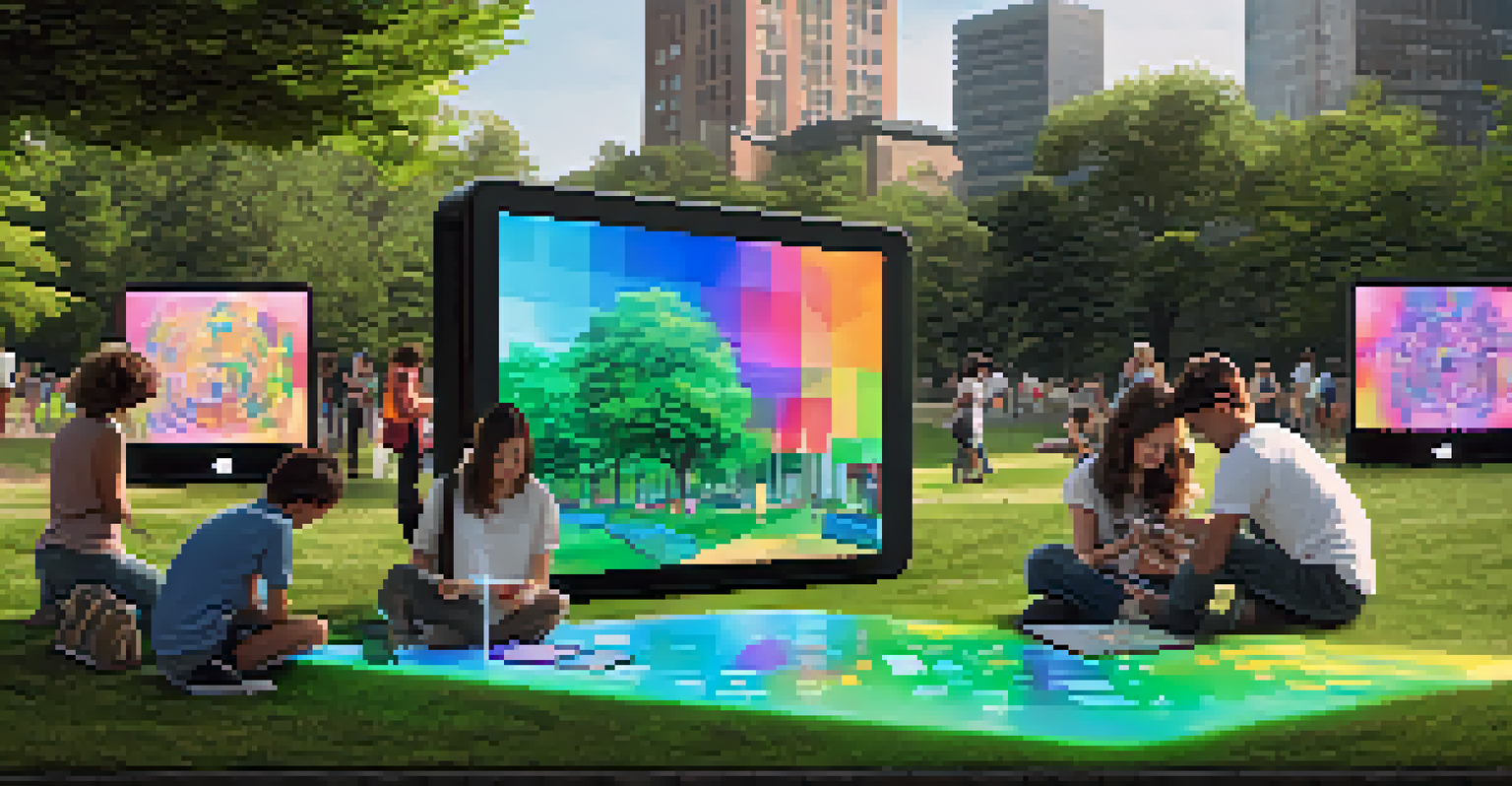The Evolution of Community Art: Trends and Future Directions

Understanding Community Art: A Brief Overview
Community art encompasses a variety of artistic expressions that engage local populations. It often involves collaboration among artists and community members to reflect shared experiences and aspirations. This form of art is not just about aesthetic value; it fosters social interactions and strengthens community bonds.
Art is the most beautiful of all lies.
Historically, community art has roots in social movements, where marginalized voices sought to be heard through creative outlets. It has evolved from traditional murals and public sculptures to encompass a wide range of mediums, including performance art and digital installations. This evolution reflects broader societal changes and the growing importance of inclusivity in art-making.
Today, community art serves as a catalyst for social change, addressing issues such as identity, belonging, and social justice. Through participatory practices, it encourages individuals to express their stories and connect with others, creating a tapestry of diverse narratives. This collective storytelling enriches both the art itself and the community's cultural landscape.
Key Trends Shaping Community Art Today
One of the most significant trends in community art is the rise of digital technology. Artists are increasingly using social media platforms to share their work and engage with audiences in real-time. This has democratized art-making, allowing anyone with internet access to participate in creative dialogues and collaborations.

Another trend is the focus on sustainability and environmental themes in community art projects. Artists are integrating eco-friendly materials and practices, raising awareness about climate change and fostering a sense of responsibility towards the planet. This shift not only beautifies spaces but also educates communities on pressing global issues.
Community Art Fosters Engagement
Community art thrives on collaboration, empowering individuals to share their stories and connect with others.
Additionally, there's a growing emphasis on mental health awareness within community art initiatives. Projects often provide safe spaces for individuals to express their emotions and experiences, promoting healing through creativity. This intersection of art and mental health highlights the therapeutic potential of community engagement.
The Role of Technology in Community Art Evolution
Technology has transformed how community art is created, shared, and experienced. Virtual reality and augmented reality tools are enabling immersive art experiences, allowing participants to engage with art in unprecedented ways. These technologies break down physical barriers, inviting broader participation from diverse communities.
The greatest art is not what you see, but what you make others see.
Furthermore, online platforms facilitate collaboration among artists across geographical boundaries. For instance, global art projects can now unite individuals from different cultures, fostering cross-cultural dialogue and understanding. This interconnectedness enriches the creative process and leads to innovative outcomes.
However, the digital divide remains a challenge; not everyone has equal access to technology. Community art initiatives must strive to bridge this gap, ensuring that all voices are included in the conversation. By addressing these disparities, we can create a more equitable artistic landscape.
Community Engagement: The Heart of Collaborative Art
At its core, community art thrives on engagement and collaboration. Artists often work alongside community members to ensure that the artwork resonates with local experiences and values. This participatory approach not only empowers individuals but also fosters a sense of ownership over the art produced.
Workshops, public forums, and collaborative projects are key methods for fostering engagement. These activities invite community members to contribute ideas, skills, and stories, creating a rich dialogue that informs the artistic process. The result is art that reflects the community's unique identity and history.
Technology Transforms Art Creation
Digital tools and online platforms are reshaping community art, enabling broader participation and cross-cultural dialogue.
Moreover, engaged communities are more likely to support and sustain artistic initiatives. When individuals feel a connection to the artwork and the artist, they become advocates for its preservation and continuation. This sustainable model is essential for the longevity of community art projects.
Challenges Faced by Community Art Initiatives
Despite the positive impact of community art, several challenges persist. Funding is often a significant issue; many projects rely on grants, donations, or sponsorships, making sustainability a constant concern. Without consistent financial support, valuable initiatives may struggle to survive or expand.
Additionally, navigating community dynamics can be complex. Artists must be sensitive to the diverse needs and perspectives within a community, ensuring that their work does not inadvertently alienate or exclude any group. Building trust and fostering open communication are critical to overcoming these hurdles.
Furthermore, the commercialization of community art poses a risk. As art becomes more marketable, there is a danger that the original intent of community engagement may be overshadowed by profit motives. Maintaining the focus on inclusivity and social impact is essential for preserving the integrity of community art.
The Future of Community Art: What Lies Ahead
Looking forward, the future of community art is bright, with limitless possibilities for innovation and engagement. As communities continue to evolve, so will their artistic expressions, adapting to new social, cultural, and technological landscapes. This adaptability is key to keeping community art relevant and impactful.
Educational institutions are increasingly recognizing the value of community art, leading to more collaborations between artists and schools. These partnerships can inspire the next generation of artists and encourage youth to engage with their communities creatively. This intergenerational exchange fosters continuity and growth in the community art landscape.
Diversity Enriches Artistic Narratives
Embracing diverse voices in community art initiatives enhances social cohesion and fosters understanding among different cultures.
Moreover, there is potential for greater integration of community art into urban planning and public policy. As cities prioritize community well-being, art can play a pivotal role in shaping public spaces that reflect and serve the needs of residents. This alignment of art and civic engagement will pave the way for a more vibrant and inclusive future.
Celebrating Diversity through Community Art
Diversity is one of the most enriching aspects of community art. By embracing different cultures, backgrounds, and perspectives, community art initiatives can create a more inclusive dialogue. This celebration of diversity not only enhances the artistic landscape but also strengthens social cohesion.
Artworks that reflect a multitude of voices can challenge stereotypes and encourage empathy among audiences. For example, projects that involve immigrant communities can illuminate their stories and experiences, fostering understanding and acceptance. This shared narrative is vital for building bridges across cultural divides.

Ultimately, celebrating diversity through community art is about recognizing and valuing every individual's contribution. By ensuring that all voices are represented, we can create a more equitable and vibrant artistic community that reflects the true fabric of society.